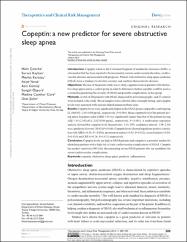Copeptin: a new predictor for severe obstructive sleep apnea

View/
Access
info:eu-repo/semantics/openAccessDate
2015Author
Çinarka, HalitKayhan, Servet
Karataş, Mevlit
Yavuz, Asiye
Gümüş, Aziz
Özyurt, Songül
Cüre, Medine Cumhur
Şahin, Ünal
Metadata
Show full item recordCitation
Cinarka, H., Kayhan, S., Karatas, M., Yavuz, A., Gumus, A., Ozyurt, S., Cure, M.C. ve diğerleri (2015). Copeptin: a new predictor for severe obstructive sleep apnea. Therapeutics and Clinical Risk Management, 11, 589-594. https://doi.org/10.2147/TCRM.S80779Abstract
Introduction: Copeptin which is the C-terminal fragment of antidiuretic hormone (ADH), is a biomarker that has been reported to be increased in various cardiovascular disorders, cerebrovascular diseases and associated with prognosis. Patients with obstructive sleep apnea syndrome (OSAS) have a tendency to develop coronary and cerebral atherosclerotic diseases. Objectives: the aim of the present study was to study copeptin levels in patients with obstructive sleep apnea and in a control group in order to determine whether copeptin could be used as a biomarker predicting the severity of OSAS and possible complications in this group. Methods: A total of 116 patients with OSAS, diagnosed by polysomnography, and 27 controls were included in the study. Blood samples were collected after overnight fasting, and copeptin levels were measured with enzyme-linked immunosorbent assay. Results:Copeptin levels were significantly higher in the OSAS group compared to control group (2,156 +/- 502; 1,845 +/- 500 pg/mL, respectively, P=0.004). Mean copeptin level of the patients having apnea-hypopnea index (AHI) >30 was significantly higher than that of the patients having AHI <30 (2,392 +/- 415; 2,017 +/- 500 pg/mL, respectively, P<0.001). A multivariate regression analysis showed that copeptin level, (hazard ratio: 1.58; 95% confidence interval: 1.09-2.30) was a predictor of severe OSAS (P=0.016). Copeptin levels showed significant positive correlation with AHI (r=0.32; P<0.001), desaturation index (r=0.23; P=0.012), arousal index (r=0.24; P=0.010) and CRP (r=0.26; P=0.011) respectively. Conclusion: Copeptin levels are high in OSAS patients and copeptin is a potential marker for identifying patients with a high risk of early cardiovascular complications of OSAS. Copeptin has modest sensitivity (84%) for discriminating severe OSAS patients who are candidates for severe cardiovascular complications.

















